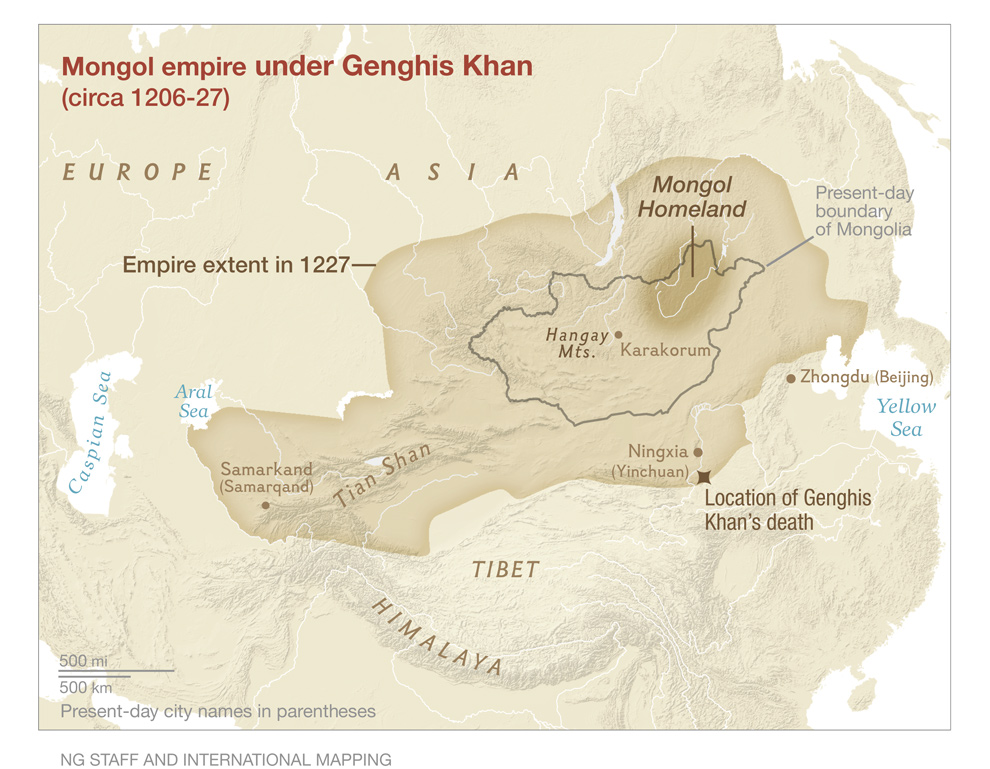It looks like you're using an Ad Blocker.
Please white-list or disable AboveTopSecret.com in your ad-blocking tool.
Thank you.
Some features of ATS will be disabled while you continue to use an ad-blocker.
9
share:
For unsuspecting herdsmen in the 13th century, April showers didn't bring May flowers—they brought Mongol hordes.
New research by tree-ring scientists from Columbia University's Lamont-Doherty Earth Observatory and West Virginia University may have uncovered the reason why an obscure band of nomadic Mongol horsemen were able to sweep through much of Asia in a few meteoric decades 800 years ago, conquering everything in their path: They enjoyed an unprecedented, and yet-to-be-repeated, 15-year run of bountiful rains and mild weather on the normally cold and arid steppes.

Very interesting read at Natural Geographic
The traditional view has been that the Mongols were desperately fleeing harsh conditions in their craggy, mountainous homeland. The Lamont-Doherty team, however, found just the opposite: Between 1211 and 1225—a period that neatly coincides with the rise of Genghis Khan and the Mongol empire—central Mongolia enjoyed a spell of sustained benign weather unlike anything the region has experienced during at least the past 1,100 years and probably much longer.
"What makes our new record distinctive is that we can see 15 straight years of above-average moisture," says the study's lead author, Neil Pedersen, a tree-ring scientist with the Lamond-Doherty Earth Observatory. "It falls during an important period in Mongol history and is singular in terms of persistently wet conditions."
The fight for resources is not always the reason for war it seems, as mongols expanded their empire more when they had more resources.
By the other hand, the article tries to relate the expansion of the empire as driven by climate change. perhaps more rain also produced a leader to drive the mongols to conquer? Yes climate change is the answer to any question now days, very interesting read non the less filled with pretty tree pictures and all
Fighting for resources is one of the biggest causes of arguments and wars that ever existed amongst humans. Acquiring metals was another big reason
for wars.
The snows melted and the grass grew abundant. Many foals and babies were born. The youth waxed strong training the animals to ride. One day, they had
an Army. And they were bored…
So some damn fool decided to "conquer the world".
So some damn fool decided to "conquer the world".
reply to post by intrptr
Boredom seems a good reason to conquer the world...
We should handle some Sudoku books to Putin/Obama et al.
Boredom seems a good reason to conquer the world...
We should handle some Sudoku books to Putin/Obama et al.
reply to post by Indigent
. Yah, nothing like handling boredom. Still, would love to have seen it.
Imagine living in a small village. One day a cry arises… you look up and over the horizon comes a thundering hoard of riders, armed to the teeth… with bad intent.
Heading straight for you.
. Yah, nothing like handling boredom. Still, would love to have seen it.
Imagine living in a small village. One day a cry arises… you look up and over the horizon comes a thundering hoard of riders, armed to the teeth… with bad intent.
Heading straight for you.
Weather changes helped and decimated civilizations.....a climate change is thought to be responsible for the fall of the great Roman Empire.
Good weather may have helped Genghis Khan, as rain means grass growing faster thus more food for their horses.
Good weather may have helped Genghis Khan, as rain means grass growing faster thus more food for their horses.
new topics
-
Petition Calling for General Election at 564,016 and rising Fast
Social Issues and Civil Unrest: 2 hours ago -
Rep. Alexandria O. Cortez Says Forcing People to Use The Correct Bathroom is Dangerous.
US Political Madness: 9 hours ago -
Cooperation zones
World War Three: 10 hours ago
top topics
-
France gives Ukraine license to fire long-range missiles at Russia
World War Three: 14 hours ago, 9 flags -
Rep. Alexandria O. Cortez Says Forcing People to Use The Correct Bathroom is Dangerous.
US Political Madness: 9 hours ago, 5 flags -
Petition Calling for General Election at 564,016 and rising Fast
Social Issues and Civil Unrest: 2 hours ago, 5 flags -
Ok this is some BS now WTH
Rant: 12 hours ago, 4 flags -
Cooperation zones
World War Three: 10 hours ago, 3 flags -
Stalker 2 - Review from a Veteran
Video Games: 17 hours ago, 2 flags
active topics
-
Petition Calling for General Election at 564,016 and rising Fast
Social Issues and Civil Unrest • 14 • : gortex -
Well, here we go red lines crossed Biden gives the go ahead to use long range missiles
World War Three • 338 • : Xtrozero -
Jaguar Rebrand Video Causes "WTF?" Moment - Seriously Weird
Automotive Discussion • 32 • : gortex -
Biden's "Reckless" Decision To Escalate Russia-Ukraine War
World War Three • 124 • : PrivateAngel -
Well we know Putins ICBMs won't fail in their silos
World War Three • 213 • : Xtrozero -
Rep. Alexandria O. Cortez Says Forcing People to Use The Correct Bathroom is Dangerous.
US Political Madness • 21 • : UpIsNowDown2 -
Congress 2024 - We do not want me in our ladies rooms
US Political Madness • 21 • : TheSingleBillie -
Results of the use of the Oreshnik missile system in Dnepropetrovsk
World War Three • 166 • : Oldcarpy2 -
Cooperation zones
World War Three • 14 • : nugget1 -
France gives Ukraine license to fire long-range missiles at Russia
World War Three • 20 • : 38181
9
